Medically reviewed by Jessica Pyhtila, PharmD, BCGP, BCPS.
Nutritionally reviewed by Diana Lee, RD.
Its scientific alias is 1,3,7,9-Tetramethyluric acid, but it’s commonly known as theacrine1. The trademarked version is called TeaCrine®. It’s essentially a milder, longer-acting caffeine. Here we’ll examine its properties, mechanisms, effects, and applications.
Disclosure: Some of the links on this page are referral links. At no additional cost to you, if you choose to make a purchase after clicking through those links, I will receive a small commission. This allows me to continue producing high-quality, ad-free content on this site and pays for the occasional cup of coffee. I have first-hand experience with every product or service I recommend, and I recommend them because I genuinely believe they are useful, not because of the commission I get if you decide to purchase through my links. Read more here.
In a hurry? Here are the highlights:
- TeaCrine® is a patented theacrine from Compound Solutions.
- It is found in nature in the kucha leaf as well as the Herrania and Theobroma plant species.
- It is structurally similar to and synergizes with caffeine and Dynamine®, and like those, enhances mood, energy, focus, and motivation.
- TeaCrine® has a slower onset, lower degree of effect, and longer duration than caffeine.
- TeaCrine® doesn’t seem to possess the tolerance, habituation, and withdrawal issues associated with caffeine.
- TeaCrine® is safe and well-tolerated at normal dosages.
Contents
What is TeaCrine?
TeaCrine® is a patented theacrine from Compound Solutions. Similar to methylliberine/Dynamine® (another of their trademarked ingredients), theacrine/TeaCrine® is an isolated purine alkoloid found primarily in the kucha tea leaf and the Cupuacu fruit2. Its effects are basically that of a slower-onset, milder, longer-duration caffeine: enhanced mood, energy, focus, and motivation.
TeaCrine Benefits
- “Clean,” smooth mental energy and focus.
- No jitters typically associated with caffeine.
- Less tolerance buildup than caffeine.
- No “crash,” habituation, or withdrawal issues usually seen with caffeine.
- Anti-fatigue.
- Elevated mood3.
- Greater motivation.
- Much longer duration (half-life) than caffeine.

About TeaCrine’s Creators
Compound Solutions is at the forefront of research-backed ingredients for the sports nutrition and supplementation industry. They are also the creators of Dynamine® and PeakO2®.
The original primary co-inventors and researchers surrounding TeaCrine® are:
- Dr. Tim Ziegenfuss, PhD, FISSN, CSCS
- Shawn Wells, MPH, RD, CISSN, FISSN
- Dr. Hector L. Lopez, M.D., CSCS, FAAPMR, FISSN
- Dr. Shawn Arent, PhD, CSCS*D, FISSN, FACSM
Listen to Matt Titlow, CEO of Compound Solutions, talk about TeaCrine® in their video below:
Click for Transcript
People have asked about TeaCrine, what is it? So it’s a compound that increases energy, mood and focus. So if we got technical, it’s a purine alkaloid, which means it’s kind of related to caffeine but it’s very different in its actual function. Caffeine actually inhibits adenosine. TeaCrine inhibits adenosine but it also activates dopamine and dopamine is your kind of, your mood and motivation neurotransmitter. So if you ask like what it is, energy, mood and focus. EMF. But, why should we care? Well, TeaCrine is incredibly complementary to caffeine. So caffeine like in the form of like coffee plus TeaCrine is amazing. If you’re going with like a pre-workout for example, it’s fantastic. So if you’re looking at caffeine alone, Red Bull or something like that, you might crash. You take TeaCrine, it smooths it and elongates that sort of energy, mood and focus that you get a higher kick in energy, mood and focus but it also goes longer. So if you, let’s say, have energy for 2 hours with caffeine, you might have it for 5 or 6 hours with caffeine plus TeaCrine. So if you don’t want that crash, you don’t want the jitters. You don’t want the habituation. This is why TeaCrine is truly special to formulate with TeaCrine. Let’s talk powders. If you’re talking powders it’s usually a pre-workout. Sometimes you have some powdered nootropics, but I would say in a pre-workout, definitely caffeine, definitely TeaCrine. And also if you want to have a little bit of more of an increase in that stimulatory effect, that energy, then Dynamine is a fantastic complement. Now you can go all kinds of different ways from there. You can use cholines, you can use adaptogens like ashwagandha, all kinds of complementary ingredients.
TeaCrine’s Mechanism of Action — How Does it Work?
Like its cousin caffeine, TeaCrine® seems to exert its effects by way of dopamine agonism (D1 and D2) and adenosine inhibition4. Adenosine is a signaler of relaxation and tiredness. Specifically, though, TeaCrine®, like Dynamine®, purportedly only allosterically modulates adenosine receptor activity (A1 and A2a; decreases sensitivity), whereas caffeine directly antagonizes (blocks) adenosine receptors. This property results in less tolerance buildup for TeaCrine® compared to caffeine.
The CEO of Compound Solutions, Matt Titlow, explains this mechanism in the video below:
Click for Transcript
People have asked us about TeaCrine and the habituation, you know, the tolerance, building up a tolerance. But you don’t with TeaCrine. You don’t build up that tolerance. You get the same effect every time, which is interesting because you’re actually adding or having feelings. It gives you feelings of energy. But interestingly, you don’t have increases in heart rate or blood pressure like you do with caffeine. So what we think is that while it’s an adenosine inhibitor, just like caffeine is, it’s also a dopamine agonist and also seems to be activating GABA and other neurotransmitters. In other words, it’s more complex than just, you know, binding to adenosine receptors giving you a feeling of energy, and we’re done. So we believe it’s a combination of how it activates various neurotransmitters, various receptors, as well as the fact that, um, you know, caffeine, you know, binds to the whole, you know, adenosine receptor. Whereas, um, TeaCrine seems to come in kind of almost like from the side, you know, kind of another key, another door in that, in that receptor. So we believe that it’s how it’s actually acting on the cell, as well as how it’s interacting with various neurotransmitters, not just adenosine, but again, also dopamine and GABA, is why it’s not creating that tolerance, that habituation, that caffeine creates.
TeaCrine vs. Caffeine
Compared to caffeine, TeaCrine® has:
- Less potential for tolerance buildup.
- Longer half-life.
- No jitters.
- No effect on blood pressure or heart rate.
- No “crash,” habituation, or withdrawal issues usually seen with caffeine.
TeaCrine vs. Dynamine
The graph below is from Compound Solutions, the makers of Dynamine® and TeaCrine®. It shows the proposed onset of action, degree of effects, and duration of Dynamine® compared to TeaCrine®5.
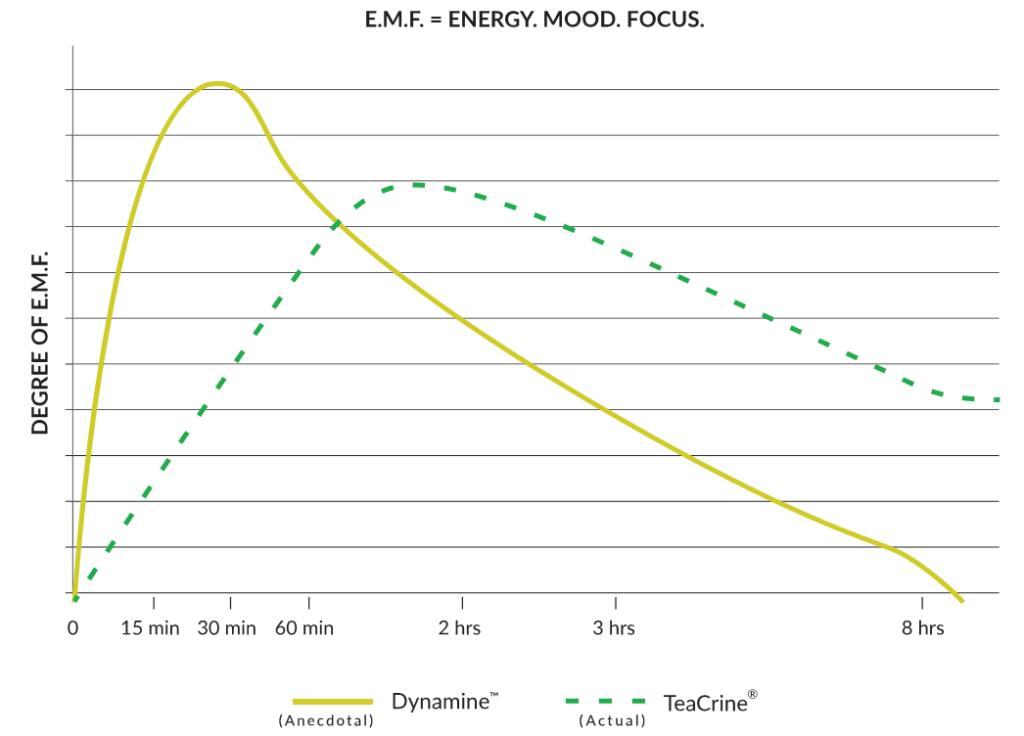
Dynamine’s shorter half-life means its effects will likely be imperceptible after about 3 hours, making it a good caffeine alternative for the afternoons or evenings, unless you want to use rutaecarpine to eliminate caffeine faster. In terms of onset and duration, TeaCrine® has a much slower onset and much longer duration than both Dynamine™ and caffeine. Specifically, it takes about 90-120 minutes to “kick in,” and will still be going 5+ hours later. As such, you’d only want to use TeaCrine® early in the day. Compound Solutions put together the following graphic showing possible dosages and goals for TeaCrine® and Dynamine™ together:
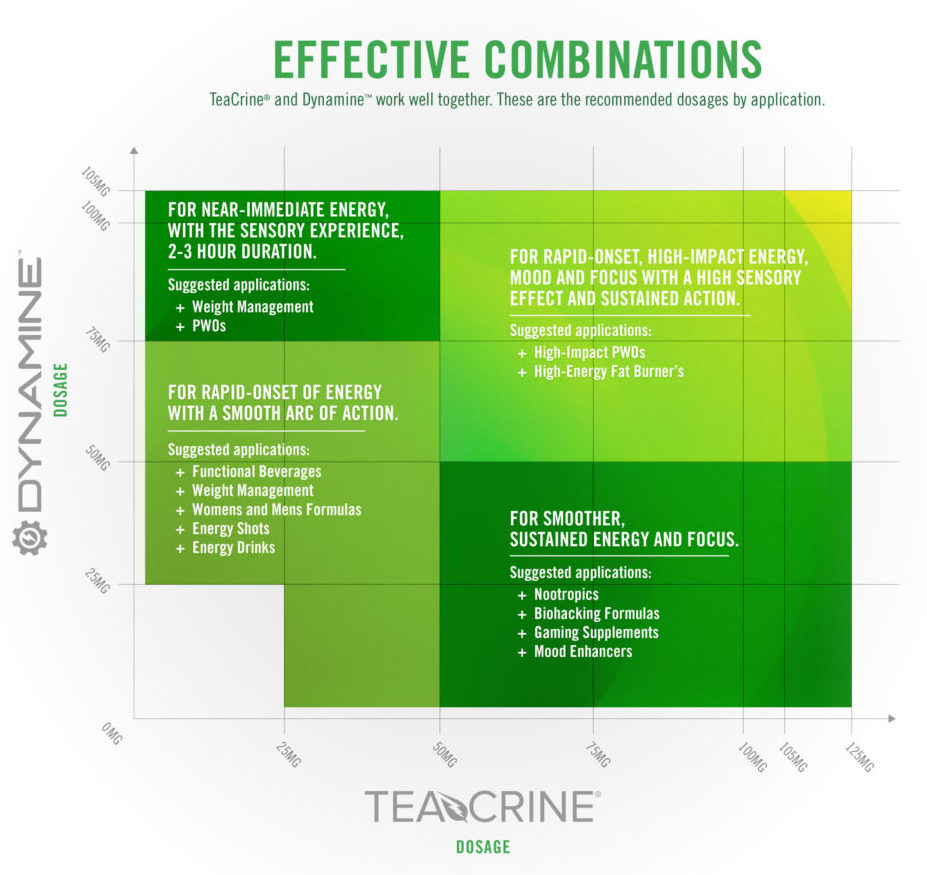
TeaCrine Studies
In 2014, Habowski et al published a study in the Journal of the International Society of Sports Nutrition, investigating “changes in various aspects of physical and mental energy and performance.” Ziegenfuss et al expanded on essentially the same study later in 2016. The researchers found that a 200mg dose of TeaCrine® yielded increased energy, reduced fatigue, and improved concentration. These results are illustrated below. No adverse side effects or changes in systemic hemodynamics were noted6,7.
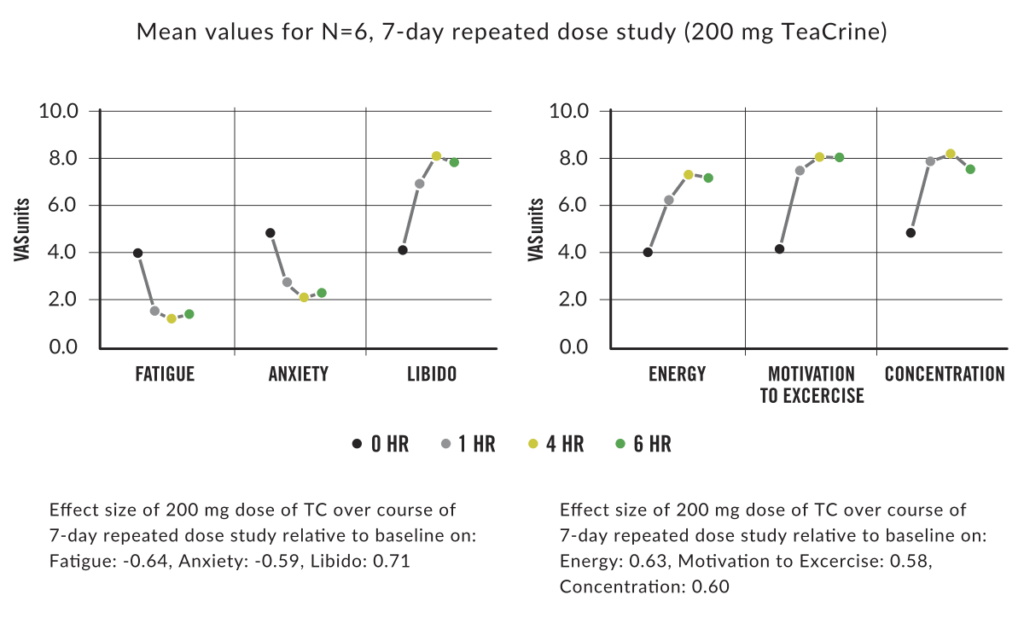
Another clinical study on TeaCrine® published in 2016 by Taylor et al aimed specifically to assess the safety and potential habituation effects of TeaCrine® supplementation. Researchers took 60 healthy men and women and put them into 3 groups: placebo, 200mg TeaCrine®, and 300mg TeaCrine®8. Prior to this study, studies assessing the safety/toxicity of TeaCrine® had only been done on rodents, in which TeaCrine® ingestion was found to be safe and well-tolerated, with no effect on blood pressure4,9. After 8 weeks of daily supplementation, researchers noted for both treatment groups:
- No effect on blood pressure.
- No effect on heart rate.
- No effect on lipid profiles.
- No effect on biomarkers of liver, kidney, and immune function.
- Reduced LDL and total cholesterol.
Basically, TeaCrine® passed with flying colors and even showed potential therapeutic effects for lowering cholesterol8.
As with Dynamine®, this puts TeaCrine® in a rare class of neuro-active substances that do not affect the cardiovascular system.
He et al investigated the potential pharmacokinetic interactions between TeaCrine® and caffeine. They found that caffeine potentiates TeaCrine®, but TeaCrine® does not potentiate caffeine. Caffeine increased maximum plasma concentration and area under the curve of TeaCrine®, but did not affect its half-life10. This is illustrated below. Note that this is the precise opposite of what is seen with Dynamine — Dynamine increases the exposure and half-life of caffeine.11
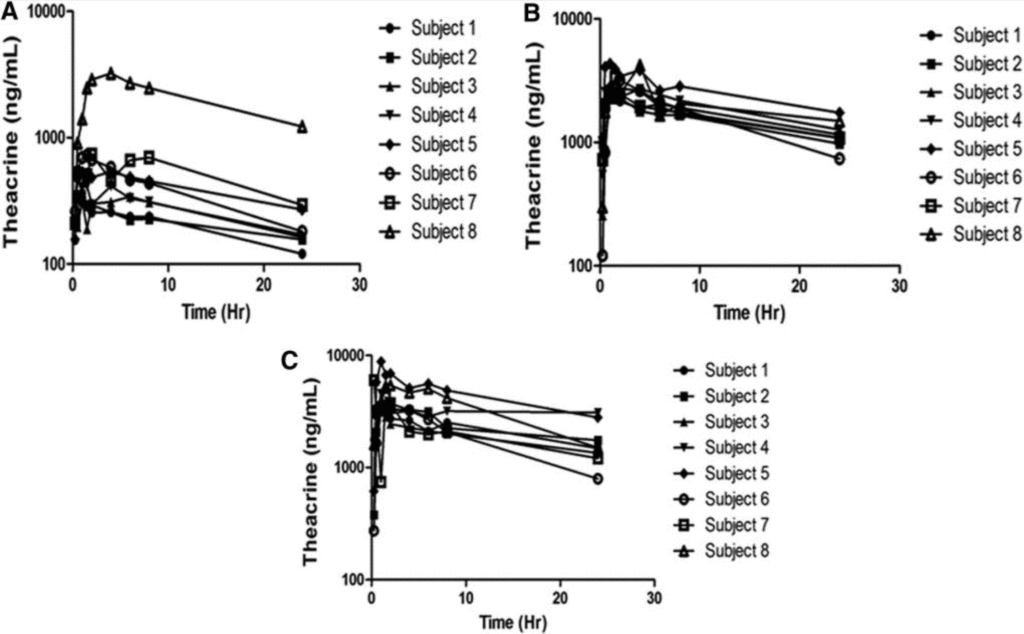
A fairly recent study from Bello et al in 2019 investigated TeaCrine’s effects on cognitive performance and time-to-exhaustion. They took 24 male and female soccer players and had them complete a 90-minute simulated treadmill soccer match over four randomized sessions (TeaCrine®, caffeine, TeaCrine® + caffeine, and placebo), and found the greatest ergogenic effects for the TeaCrine® + caffeine group12. Watch the video below to see the researchers explain the design and results of the study:
Click for Transcript
So the original study we did with TeaCrine. Um, what we did is we had 4 groupings. We had a placebo, the TeaCrine by itself, caffeine by itself, and then a TeaCrine caffeine combination. So the two of them were put together to equal the doses in the other two conditions. Uh, so we were dealing with 275 milligrams of each by themselves, and then 275 milligrams put together. So I believe it was 150 and 125. Anyway, what we did is we were working with soccer players at the division 1 level and professional. So these are pretty high level players. And what we did is we developed a 90 minute protocol that was basically a game simulation on the treadmill. So we went back to data on high level players and looked at the time spent in different speed zones, the percentage of the game that was done doing that, and we came up with a protocol and then used our own GPS data from our female athletes to scale that for the females in the study. So it was interesting because then what we did, we brought them in, we dosed them with whatever that condition was. So it was a totally within-subjects design. Then what we did is we did their warmup and then at halftime and end of game, so we kept the same 15 minute halftime. We brought them in right at the end of that 90 minutes, so end of game, we brought them into our reaction time room and we had them do three different tasks. One was a simple reaction time. Light goes, you go, all right, so it’s hand movement. The second one was choice reaction time. So what it was, it was a red or green light, but it was conflicting. So in other words, you went on red, you stayed on green. Okay, so now it was a go, no go. And then the last thing that we did was what we call the cognitive reaction time, where it’s that choice reaction time, green, red. But at the same time you also had to solve a problem. So there’s a little screen on it that comes up and it basically gives you a math problem or a word that you’d have to read out loud or solve the math problem. And what you’d do is you then have to say that and respond at the same time. We let them finish the rest at halftime or at the end of the game. After these tests, what we did is at the very end of the game then to simulate added time and an overtime scenario, we’d then bring them right back in on the treadmill, put them at 85% of their VO2 max, and run to exhaustion. So how long can you go?
So for our study design for the first TeaCrine and soccer protocol, we had two big questions that we wanted to ask. Based on the previous research with caffeine, we wanted to see how either the placebo, all caffeine, all TeaCrine, or the combination affects these athletes in both a cognitive sense and cognitive performance and the physical performance sense.
So what’s interesting is when you add TeaCrine to the caffeine, to what we already know, caffeine does so well, is you get that tail end, the effect where you normally would see a drop off in performance, either neuro motor, neurocognitive, or physical performance benefits from caffeine. You can pick up that tail when you combine TeaCrine with caffeine.
The key findings really were the combination condition. They seem to show the most benefit and more of a synergistic between the two. Overall, on the run time to exhaustion, we saw the most benefit in that with a 38% improvement compared to placebo. When you’re talking, you know, in a soccer game and overtime, that 30% can mean winning or losing.
Bello et al concluded that “the 27–38% improvements in TTE reflect increased performance capacity that may have important implications for overtime scenarios. These findings suggest TeaCrine® favorably impacts endurance and the combination with caffeine provides greater benefits on cognitive function than either supplement independently.”12 The graph below shows TTE from this study. PL = placebo. TCR = TeaCrine®. CAF = caffeine. TCR+CAF = TeaCrine® + caffeine.
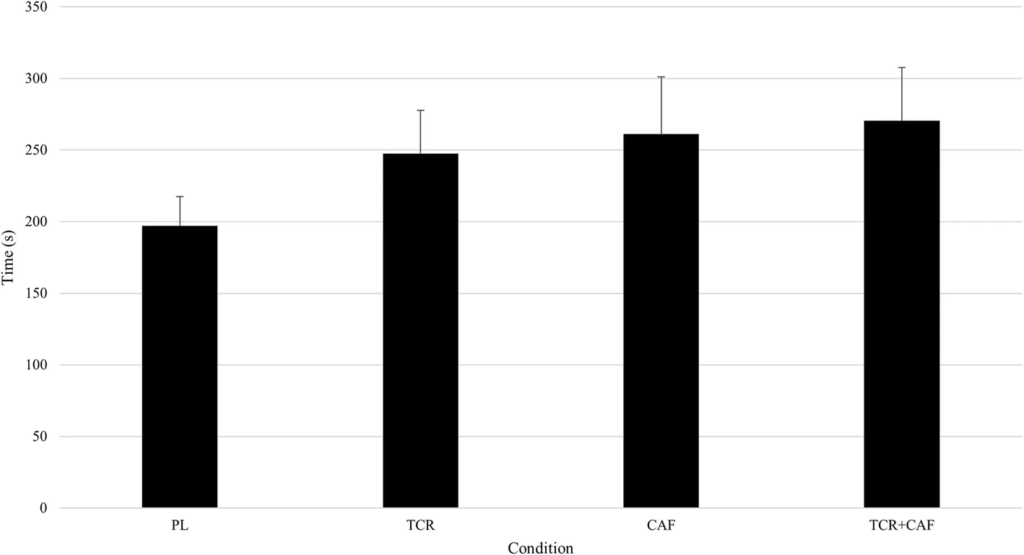
Another recent study took 24 college students to see effects of various combinations of Dynamine® and TeaCrine® on heart rhythm, resting heart rate, blood pressure, and psychometric parameters. Participants were assigned randomly to one of the following groups:
- Low-dose Dynamine (100mg)
- High-dose Dynamine (150mg)
- Low-dose Dynamine with TeaCrine (100mg Dynamine + 50mg TeaCrine)
- High-dose Dynamine with TeaCrine (150mg Dynamine + 25mg TeaCrine)
- Placebo (125mg Maltodextrin).
After 4 weeks of daily supplementation, researchers found no significant effects on heart rhythm, RHR, BP, or PP. There were no adverse effects reported13.
My TeaCrine Review
As suspected, TeaCrine® provided a long-lasting, clean, smooth energy and focus, not unlike a 1:1 caffeine-plus-theanine combination wherein theanine “smooths out” caffeine. One should be able to take 1 dose of TeaCrine® in the morning to last almost the entire 8-hour work day. Depending on your dopamine and adenosine sensitization, you may have to increase the dosage and/or combine with caffeine to make the effect last that long. Start small and work your way up.
There’s also definitely a perceptible synergistic effect with caffeine, as the research has shown. A subtle but important takeaway from that verified synergism is that it allows for the same EMF (energy, motivation, focus) enhancement with a lower dose of caffeine. There are plenty of benefits from that:
- Increased EMF without hitting the threshold for the jitteriness that accompanies higher caffeine doses.
- Less potential for tolerance buildup.
- Less potential for caffeine withdrawal symptoms.
- No caffeine “crash,” which is essentially just a rebound spike of adenosine.
- Less stress on the cardiovascular system (potential for lower or no effect on blood pressure and heart rate)14,15.
- Less effect on stress hormones like cortisol and noradrenaline.
Is TeaCrine Safe?
Recall that Taylor et al found no adverse effects on blood pressure, heart rate, lipid profiles, or liver and kidney biomarkers8. Other studies have confirmed these findings, and a later toxicological assessment of theacrine showed “the NOAEL for theacrine is considered to be 180 mg/kg bw/day in male and female Wistar rats.”16 NOAEL is the no-observed-adverse-effect-level.

TeaCrine® received self-affirmed GRAS (Generally Regarded As Safe) status later that same year in 201617.
Theacrine has an LD50 (dosage to kill 50% of the population) of 810.6 mg/kg in mice, which would equate to about 4 g for a human individual weighing 76 kg (168 lbs.)2.
As such, TeaCrine® is safe for human consumption at normal dosages.
TeaCrine Side Effects
Negative side effects from TeaCrine® are rare. People either seem to complain of being too stimulated – from combining TeaCrine® with caffeine and perhaps Dynamine® (remember, caffeine potentiates TeaCrine®) – or of difficulty falling asleep due to TeaCrine’s long half-life. For that reason, be sure to take TeaCrine® early in the day. Adding theanine to the mix should mitigate these unwanted effects.
TeaCrine Dosage
Most TeaCrine® supplements put the recommended dosage in the 100-300mg range, taken once daily. If taken with caffeine and/or Dynamine®, start small and work your way up.
TeaCrine Half-Life
TeaCrine® has an extremely long half-life that is thought to be around 20 hours, with effects tapering off and likely being imperceptible after about 6 hours. Onset of TeaCrine® happens around 1 hour after ingestion. Peak concentration occurs around the 1.5 hour mark.
TeaCrine Pre-Workout
TeaCrine® is useful as a pre-workout supplement if you’re looking to maintain that enhanced energy, focus, and motivation after your workout, since its effects last so long. This makes it perfect for someone who perhaps works out in the morning and then goes straight to work to tackle the day. Some popular pre-workout supplements that contain TeaCrine® include:
TeaCrine Supplements
TeaCrine’s inherent properties and synergism with caffeine make it a good candidate for pre-workout supplements, fat burners, energy drinks, and nootropic blends, or simply by itself for a clean, smooth, all-day energy. The combination of theacrine and caffeine has been clinically shown to be safe18.
To run the “n=1” studies on myself when trying new compounds, I always think it’s imperative to try an ingredient in isolation first instead of within a blended supplement. Otherwise, how can you know you’re seeing a discernible effect from one ingredient?
Like Compound Solutions, Nootropics Depot is all about quality, and transparency. I get many of my nootropics from them. They’re one of the best names in the supplement industry. They have a proven track record of providing the highest-quality research-backed ingredients with verifiable third-party analytical testing and in-house testing. They also happen to have great customer service and fast shipping. For a while now, they’ve been part of the antidote to the issues that have plagued the supplement industry and given it a bad reputation – label inaccuracy, questionable purity and safety, and lack of efficacy. In short, make sure you’re buying from a trusted seller and make sure you know what you’re getting.
Other TeaCrine Reviews
As an added bonus, watch some other people discuss TeaCrine® in the video from Compound Solutions below:
Click for Transcript
One of the great things I love about TeaCrine is in its full dose form, it does a phenomenal job accelerating, the, you know, your alertness and your energy levels without some of the issues that you have with caffeine. It has a beautiful effect, what appears to be a beautiful effect on reducing that drop off that you get with caffeine typically. And also just sort of taming that, that high peak that you get with caffeine. And so you get a much more smooth overall delivery of energy, which is phenomenal. And our consumers are just going crazy for it.
Of all the reviews we’ve gotten, there’s two negative reviews and not to talk about negative reviews, but they are literally by people who drink 8 ounce red bulls and monsters every day saying, this drink is way too powerful for me, which is exactly what I want to hear. Right. And I think it’s that combination of the TeaCrine and the caffeine coming through, giving them that experience, hitting them every time. So I don’t even view those as negative.
Let’s just call it a, I like to call it like a caffeine catalyst really helps activate that ingredient a little bit more. It gets you a little more punch to your product. I think one of the more common responses we get is crash free. You know, a lot of the hardcore stimulants out there, they tend to leave you feeling groggy afterwards, you know, a big come down after your workout and you don’t really seem to get that from TeaCrine.
You want to win, put TeaCrine in.
References
- 1.PubChem Database. 1,3,7,9-Tetramethyluric acid. National Center for Biotechnology Information. https://pubchem.ncbi.nlm.nih.gov/compound/1_3_7_9-Tetramethyluric-acid
- 2.Zheng X-Q, Ye C-X, Kato M, Crozier A, Ashihara H. Theacrine (1,3,7,9-tetramethyluric acid) synthesis in leaves of a Chinese tea, kucha (Camellia assamica var. kucha). Phytochemistry. Published online May 2002:129-134. doi:10.1016/s0031-9422(02)00086-9
- 3.Kuhman D, Joyner K, Bloomer R. Cognitive Performance and Mood Following Ingestion of a Theacrine-Containing Dietary Supplement, Caffeine, or Placebo by Young Men and Women. Nutrients. 2015;7(11):9618-9632. doi:10.3390/nu7115484
- 4.Feduccia AA, Wang Y, Simms JA, et al. Locomotor activation by theacrine, a purine alkaloid structurally similar to caffeine: Involvement of adenosine and dopamine receptors. Pharmacology Biochemistry and Behavior. Published online August 2012:241-248. doi:10.1016/j.pbb.2012.04.014
- 5.Compound Solutions, Inc. Dynamine Natural Energy Supplement -Dynamine Supplements. Compound Solutions. Accessed May 19, 2019. https://www.compoundsolutions.com/dynamine.html
- 6.Habowski S, Sandrock J, Kedia A, Ziegenfuss TN. The effects of TeacrineTM, a nature-identical purine alkaloid, on subjective measures of cognitive function, psychometric and hemodynamic indices in healthy humans: a randomized, double-blinded crossover pilot trial. J Int Soc Sports Nutr. Published online 2014:P49. doi:10.1186/1550-2783-11-s1-p49
- 7.Ziegenfuss TN, Habowski SM, Sandrock JE, Kedia AW, Kerksick CM, Lopez HL. A Two-Part Approach to Examine the Effects of Theacrine (TeaCrine®) Supplementation on Oxygen Consumption, Hemodynamic Responses, and Subjective Measures of Cognitive and Psychometric Parameters. Journal of Dietary Supplements. Published online May 10, 2016:9-24. doi:10.1080/19390211.2016.1178678
- 8.Taylor L, Mumford P, Roberts M, et al. Safety of TeaCrine®, a non-habituating, naturally-occurring purine alkaloid over eight weeks of continuous use. J Int Soc Sports Nutr. Published online January 13, 2016. doi:10.1186/s12970-016-0113-3
- 9.Li S-B, Li Y-F, Mao Z-F, et al. Differing chemical compositions of three teas may explain their different effects on acute blood pressure in spontaneously hypertensive rats. J Sci Food Agric. Published online July 24, 2014:1236-1242. doi:10.1002/jsfa.6811
- 10.He H, Ma D, Crone LB, et al. Assessment of the Drug–Drug Interaction Potential Between Theacrine and Caffeine in Humans. Journal of Caffeine Research. Published online September 2017:95-102. doi:10.1089/jcr.2017.0006
- 11.Compound Solutions. Dynamine® [NEW CLINICAL TRIAL]: Researchers discovered that Dynamine® extends caffeine’s half-life and increased its area under the curve approximately two-fold. PRWeb. Published February 28, 2020. https://www.prweb.com/releases/dynamine_new_clinical_trial_researchers_discovered_that_dynamine_extends_caffeines_half_life_and_increased_its_area_under_the_curve_approximately_two_fold/prweb16941379.htm
- 12.Bello ML, Walker AJ, McFadden BA, Sanders DJ, Arent SM. The effects of TeaCrine® and caffeine on endurance and cognitive performance during a simulated match in high-level soccer players. J Int Soc Sports Nutr. Published online April 18, 2019. doi:10.1186/s12970-019-0287-6
- 13.Proceedings of the Fifteenth International Society of Sports Nutrition (ISSN) Conference and Expo: Clearwater Beach, FL, USA. 7-9 June 2018. J Int Soc Sports Nutr. 2018;15(Suppl 1):1-37. doi:10.1186/s12970-018-0256-5
- 14.Riksen NP, Rongen GA, Smits P. Acute and long-term cardiovascular effects of coffee: Implications for coronary heart disease. Pharmacology & Therapeutics. Published online February 2009:185-191. doi:10.1016/j.pharmthera.2008.10.006
- 15.Petermann J, Baumann T. Metabolic Relations between Methylxanthines and Methyluric Acids in Coffea L. Plant Physiol. 1983;73(4):961-964. https://www.ncbi.nlm.nih.gov/pubmed/16663351
- 16.Clewell A, Hirka G, Glávits R, et al. A 90-Day Oral Toxicological Evaluation of the Methylurate Purine Alkaloid Theacrine. Journal of Toxicology. Published online 2016:1-17. doi:10.1155/2016/6206859
- 17.Compound Solutions. TeaCrine® from Compound Solutions, Inc. Receives GRAS Affirmation. PRWeb. Published August 16, 2016. https://www.prweb.com/releases/2016/08/prweb13611582.htm
- 18.He H, Ma D, Crone L, et al. Assessment of the Drug-Drug Interaction Potential Between Theacrine and Caffeine in Humans. J Caffeine Res. 2017;7(3):95-102. doi:10.1089/jcr.2017.0006
Medical Disclaimer: While I love diving into and extracting useful information from clinical research related to health, fitness, supplements, and more, I am in no way a medical expert. The content on this website is for informational purposes only; it is not professional medical advice, nor is it a substitute for professional medical advice. None of the statements on this website have been evaluated by the FDA. Products mentioned are not intended to diagnose, treat, cure, or prevent any disease. Read my lengthier medical disclaimer here.
Leave a Reply